
How To Get Rid Of Pests On Hot Pepper Plants
Just the word "pests" can strike fear into the hearts of even the most seasoned pepper-growing experts. However, it needn't be the catastrophe it's made out to be. Here we share our secrets on how to deal with a pest infestation, and how to prevent one. We're confident we can help you on your way to achieving hot pepper perfection in no time.
We all want the best for our pepper plants. We strive to provide them with the best possible conditions so they can flourish and provide us with a massive harvest of peppers to enjoy for a long time to come. However, try as we might, a common problem can arise during the growing cycle, wreaking havoc on our plants. We are, of course, talking about the presence of pests. Here we give you the lowdown on everything you need to know about combatting and preventing pepper pests, to see that they don't irrevocably impact or impede your plant.
Hot pepper pests
So, what common pests should you be on the lookout for, and what are some telltale signs a potential infestation is in the works? Timing is everything in terms of eradicating pests. Recognising signals early will allow you to act quickly and stop a pest attack from turning into a full-blown infestation. Let's take a look at some of the key garden pests you should be wary of.
Aphids

Although they come in all shapes, sizes, and colours, these tiny insects are usually identifiable by their pear-shaped bodies and long antennae. Whereas some pests will be buzzing around your plant, aphids like to hide and play the waiting game, lying in wait in various sections of the plant, such as the underside of leaves, all while doing damage to your precious plant. Here are the key signs to look out for.
Clusters under leaves
Be sure to check underneath the leaves to ensure no clusters of aphids are present.
Dark spots on leaves
As aphids feed on the sap from the plant, keep an eye out for dark spots on the veins of the leaf. This is a clear indication of an aphid infestation.
Damaged new growth
Lastly, aphids tend to gravitate toward the newer leaves on the plant, so be sure to check out the smaller ones too!
Potato beetles
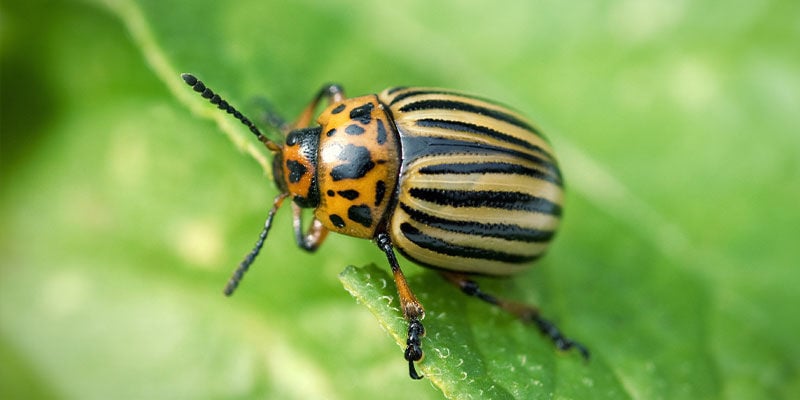
They might look pretty cute and reminiscent of ladybugs, but don't be fooled for a second by the potato beetle; they're set out to do damage! While they are primarily drawn to potato plants (hence the name), they also enjoy tomato and pepper plants too. They are characterised by their yellow/orange and round bodies with black-striped wings. They feed on the plant's leaves and lay eggs, allowing subsequent larvae to destroy your plant too.
Damaged leaves
Keep an eye out for any holes in the leaves. Damage to the leaves can severely impact the health of your plant, as well as the fruits produced.
Clusters under leaves
Much like aphids, potato beetles like to hide on the underside of leaves. However, a major plus is that their distinct and bright colouring is their downfall, making them easy to spot and deal with.
Pepper maggots
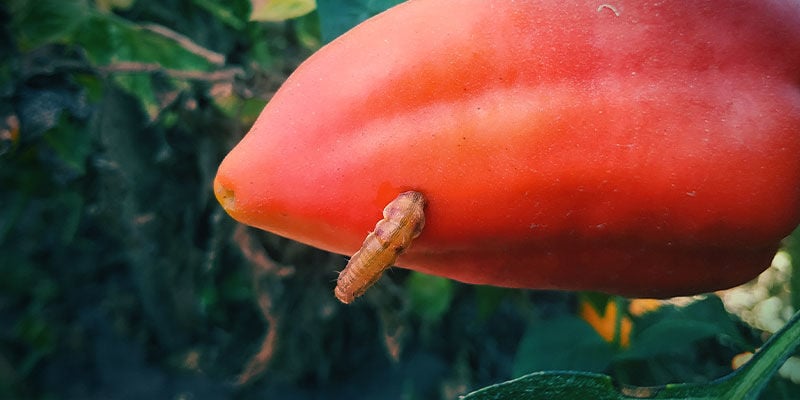
These nasty creepy crawlies result from flies landing directly on your carefully cultivated chillies and laying eggs in the fruit. As you can probably guess, the ensuing maggots will eat away at the pepper, causing irrevocable damage and rotting the inside of the now-inedible fruit.
Compromised pepper skin
As you can imagine, the eggs are tiny, but there are some telltale signs to clue you in. Check the pepper's surface for small dimples where the skin has been penetrated. It may take a keen eye and attention to detail, but preventing an outbreak of pepper maggots is of the utmost importance.
Whiteflies
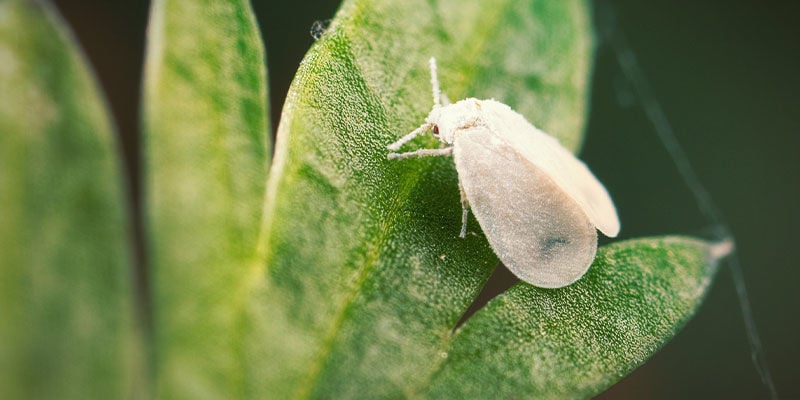
Whiteflies are a close relative of aphids and bear a similar resemblance, except, no surprises; they're white. However, they terrorise pepper plants like you wouldn't believe. But fortunately, they are mainly active during the day, which is a major plus in terms of identifying a potential infestation.
Clusters under leaves
Much like aphids, whiteflies also choose to congregate underneath leaves, so it's not unusual to see a group of them there. They also like to lay eggs in that area too, so be sure to deal with them quickly.
Damaged new growth
Whiteflies have a taste for newer leaves on the pepper plant, so check freshly sprouted areas first.
Spider mites
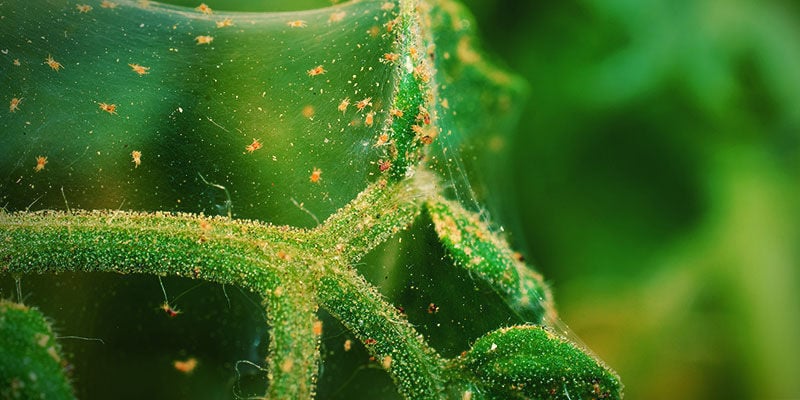
These insect-like arachnids are arguably the hardest to discover on your pepper plants. With some appearing as small as a grain of sand, spider mites can be dismissed as a speck of dust or dirt if not properly investigated. Of course, just because they're small doesn't mean they can’t do damage once embedded in your plant and the fruit produced.
Damaged, dying leaves
Spider mites feed on the surface of the leaves, leaving them in a crippled and malnourished condition—eventually leading to curled, dried, and subsequently dead leaves that will fall from the plant.
Damaged peppers
Not only content on wrecking your leaves, spider mites also enjoy feasting on the flesh of peppers. Similar to the leaves, they leave the pepper in a malnourished and unhealthy state, with withered and discoloured skin.
How to get rid of pests on hot pepper plants
We've given you a heads up on the kind of pests you might come up against, so how can you get rid of them should they rear their heads? Fortunately, there are plenty of ways to deal with pepper-loving pests. As mentioned, it's a case of acting quickly and decisively to prevent any lasting damage to your plants. So let's check out what you can do to prevent disaster.
Natural pesticides
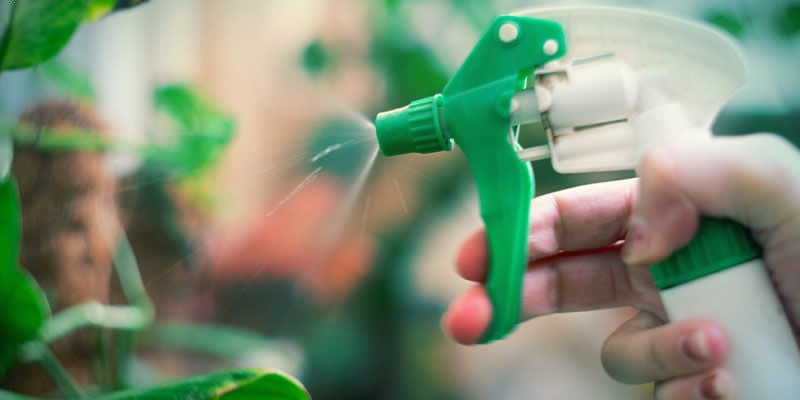
Many turn to natural pesticides to thwart any pests looking to damage their pepper plants. All-natural plant remedies are often favoured, as they bypass the use of synthetic solutions that can damage the plant further.
Examples of natural pesticides include the tried and tested neem oil spray. This is a solution made from oil extracted from the neem tree mixed with a bit of dish soap and warm water. The result is simply devastating to practically all pests and intruding insects, killing them no matter where they are on the plant.
Others use homemade garlic spray on their pepper plants to deter and repel pest infestations. However, there are many, many different types of natural pesticides you can try at home.
Removing pests manually
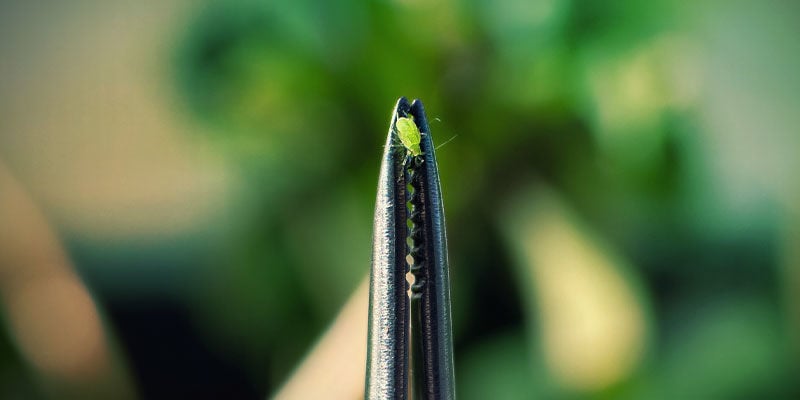
Although a little more hands-on (literally), it's entirely possible to remove pests from plants manually. Of course, this is a more appropriate option for minor infestations, and can be seen as more of a preventative measure. While a more labour and time-intensive method, it’s the least damaging to your plant, as long as you use the right tools and a bit of care. To remove pests by hand, look to use one or more of the following.
Tweezers
For tiny pests that are hard to pick up, consider using tweezers to remove them from your plant.
Rubber gloves
You don't want to get your hands dirty, nor do you want to contaminate your plant further, so be sure to put gloves on before picking those pests off the leaves.
Garden hose
If the infestation is mild, simply spray the hose on those pesky pests. Washing them off the plant might be enough to keep them at bay. Also, you'll be giving your plants a drink at the same time—a true win-win.
Soapy water
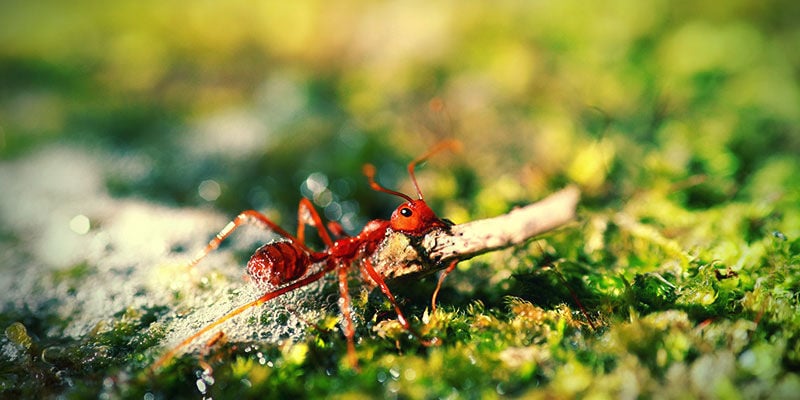
As touched upon above, pests hate concoctions that include soapy water. If you want to forego adding an additional oil such as neem or peppermint, simply load up a spray bottle with a little warm, soapy water and go to work on the leaves and other affected areas of your plant (avoiding the fruits). This will make short work of any pests and potential offspring. Use sparingly and accurately, and your pest problem will be a thing of the past.
Ladybugs
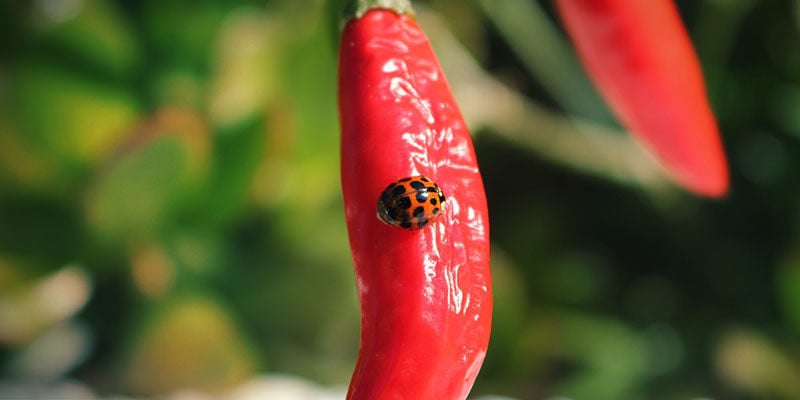
Another all-natural defender, consider introducing some ladybugs into the situation, and allow these beneficial insects to take care of the pests for you. Ladybugs love eating aphids and other pepper plant bugs, so think of them as your plant protectors or pest assassins, whichever suits you best.
You can look to collect ladybugs over the summer months and then introduce them into your setup; or, for a less time-consuming, more straightforward approach, you can head over to your local garden centre and purchase a pack of live ladybugs and let them settle in. Keep a couple of small dishes of water around your plant and spray the leaves too, and the ladybugs will have everything they need.
And don't worry about the safety of your peppers and leaves; ladybugs won't start going for them once they run out of pests; they'll keep protecting for some time.
Diatomaceous earth
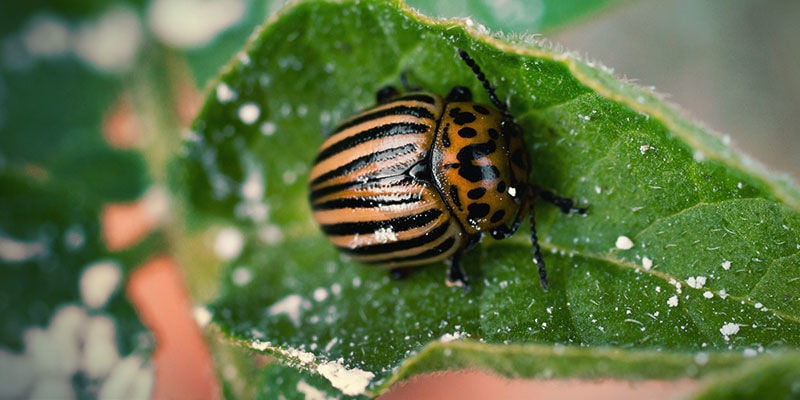
This all-natural sedimentary rock is perfect for dealing with pests. The rock is crumbled into a fine, dusty powder that you can “pepper” your leaves with. The impact this has on pests is huge, as it will cause them to become massively dehydrated and die.
When applying diatomaceous earth to your plant, it is recommended to use gloves and goggles, as it can cause irritation should it get into a cut or the eyes. But where do you find diatomaceous earth? Fortunately, it's very easy to get a hold of; a quick online search or visit to your local garden centre will allow you to pick up a bag that's ready to use.
How to prevent pests on hot pepper plants
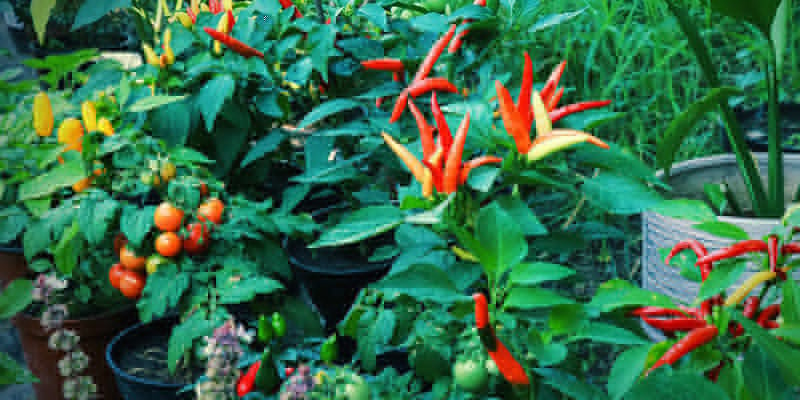
While the aforementioned ways of getting rid of pests should work if you find yourself infested, prevention is always the best solution. Here are a few methods you can use to deter any pest assaults from happening in the first place.
Maintenance and housekeeping
As arguably the most crucial factor in prevention, a well-maintained plant is a healthy one. Now, we're not talking about being overbearing by overfeeding or overwatering, but keeping a strict maintenance schedule for your pepper plants is paramount for their health.
Be sure to remove any unhealthy or dead leaves to eliminate a potential breeding ground for pests. Keep the soil moist but not soaked (to avoid various issues), and you'll be on to a well-performing plant.
Daily observation
Tying into maintenance and housekeeping, daily observation is key. Undertaking tasks such as checking the quality of the leaves and fruits throughout the growing cycle will allow you to catch and deal with any pests early and easily.
Some avid growers even take photos of their plants daily to compare their current appearance to a previous date. Certainly not a bad idea if you're looking to have complete control over your pepper plants.
Companion plants
Similar to the effects of neem oil and other deterrents, many growers introduce companion plants into their home growing setup. You might think that a companion plant would entice pests toward your pepper plants or have a negative impact on their fruits, but this is not the case. By positioning plants such as chives, mint, or garlic next to your peppers, pests will be put off from exploring your plants. Trust us; it works incredibly well.
Make pepper pests a thing of the past
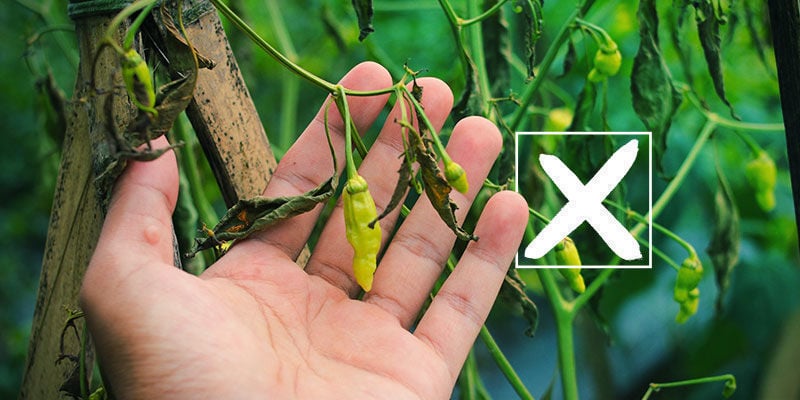
As you can see, there are many different ways to prevent and deal with pepper plant pests. So if you notice a few aphids crawling around, don't panic! Follow our steps to success, and your plant will be back on track in no time at all. Dealing with infestations and infections is part of pepper cultivation, and you'll likely run into a problem or two along the way.
It's essential to focus on the positives, and to just do your best. As soon as you've dealt with any issue, you'll gain invaluable knowledge that will help you on your next pepper project, the one after that, and so on.
-
 8 min
18 March 2022
How To Grow Hot Peppers Outdoors
There's nothing quite like having your own supply of spicy hot peppers. And while it may seem a daunting task to grow them outdoors, we're here to show that it's really not! All you need to do is...
8 min
18 March 2022
How To Grow Hot Peppers Outdoors
There's nothing quite like having your own supply of spicy hot peppers. And while it may seem a daunting task to grow them outdoors, we're here to show that it's really not! All you need to do is...
-
 7 min
4 March 2022
How To Grow Hot Peppers Indoors
Growing chillies might seem like a complicated task, but we're here to tell you that it really needn't be. Even if you don't have an adequate space outside to grow them, you can produce some...
7 min
4 March 2022
How To Grow Hot Peppers Indoors
Growing chillies might seem like a complicated task, but we're here to tell you that it really needn't be. Even if you don't have an adequate space outside to grow them, you can produce some...
-
 7 min
12 August 2021
Growing Peppers For Beginners In 10 Easy Steps
Growing peppers at home can be a hugely rewarding task. Harvesting your own carefully cultivated chillies to use in cooking is a great feeling. But, from seed to harvest, how do you achieve this?...
7 min
12 August 2021
Growing Peppers For Beginners In 10 Easy Steps
Growing peppers at home can be a hugely rewarding task. Harvesting your own carefully cultivated chillies to use in cooking is a great feeling. But, from seed to harvest, how do you achieve this?...
-
 4 min
5 August 2021
Hot Peppers And The Scoville Scale
There's no denying the appeal of spicy food. Whether you're keen on Mexican delicacies, Pad Thai, or Vindaloo curries, they have one thing in common; peppers.
4 min
5 August 2021
Hot Peppers And The Scoville Scale
There's no denying the appeal of spicy food. Whether you're keen on Mexican delicacies, Pad Thai, or Vindaloo curries, they have one thing in common; peppers.














 United States
United States










